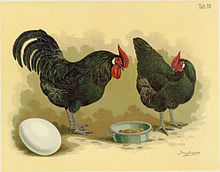Rhinelander (chicken)
The Rheinländer Huhn or the Rhinelander is a German breed of chicken, which was bred from the Eifler Landhuhn at the end of the 19th century. It is characterized by a robust constitution and good laying and fattening properties. There is also a dwarf variant .
history
The Rhinelander originated as a Cologne sugar manufacturer named Dr. Hans Rudolf von Langen found stocks of original regional chickens in the Eifel and crossed them with a French breed that was now almost extinct and bred again - Le Mans. The new breed was selected from the start for egg production , meat set, trust and disease resistance. The first exhibition took place in 1907. In 1908 the "Rhinelander Züchter-Klub" was established, whereupon different color varieties were developed. With a total population of less than 2000 animals, the breed is classified as "endangered" (Category III), according to the Red List of the Society for the Conservation of Old and Endangered Domestic Breeds.
features
The breed comes in the colors black, partridge-necked, silver-necked, blue-lined, sparrowed , white, blue-partridge-necked, white-black columbia, orange-necked and color-coded. The rectangular shape of the trunk ("brick shape") and the compact rose crest are striking. The legs are slate-colored, the ear discs white. The hens lay around 140–180 white eggs per year. The hens weigh about 2.5 kg, the roosters up to 3 kg.
Special association
In Germany, the special association of breeders of the Rhinelander and Dwarf Rhinelander Chickens eV is responsible for breeding care.
credentials
- ↑ a b Information from the special association at sv-rheinlaenderhuhn.jimdo.com , accessed on June 23, 2019
- ↑ Breed description on geh.de , accessed on June 23, 2019
